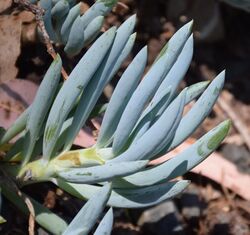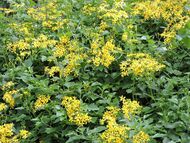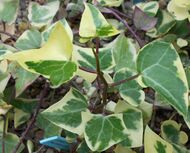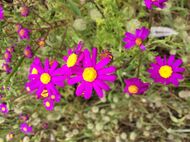Biology:Senecio
| Senecio | |
|---|---|
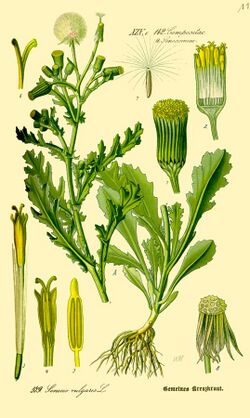
| |
| Senecio vulgaris, an illustration from 1885. | |
| Scientific classification | |
| Kingdom: | Plantae |
| Clade: | Tracheophytes |
| Clade: | Angiosperms |
| Clade: | Eudicots |
| Clade: | Asterids |
| Order: | Asterales |
| Family: | Asteraceae |
| Subfamily: | Asteroideae |
| Tribe: | Senecioneae |
| Genus: | Senecio L. |
| Type species | |
| Senecio vulgaris | |
| Species | |
|
Some 1,250; see text | |
| Synonyms[1] | |
|
Dendrosenecio | |
Senecio /sɪˈniːʃi.oʊ/[2] is a genus of flowering plants in the daisy family (Asteraceae) that includes ragworts and groundsels.
Variously circumscribed taxonomically, the genus Senecio is one of the largest genera of flowering plants.
Description
Morphology
The flower heads are normally rayed with the heads borne in branched clusters, and usually completely yellow, but green, purple, white and blue flowers are known as well.
In its current circumscription, the genus contains species that are annual or perennial herbs, shrubs, small trees, aquatics or climbers. The only species which are trees are the species formerly belonging to Robinsonia occurring on the Juan Fernández Islands.[3]
Chemistry
Pyrrolizidine alkaloids are found in all Senecio species. These alkaloids serve as a natural biocides to deter or even kill animals that would eat them. Livestock generally do not find them palatable.[4] Senecio species are used as food plants by the larvae of some Lepidoptera species that have developed tolerance for these alkaloids.
Taxonomy
The traditional circumscription of Senecio is artificial, being polyphyletic, even in its new circumscription which is based on genetic data.[5][6] Despite the separation of many species into other genera, the genus still contains c. 1,250 species and is one of the largest genera of flowering plants.[7]
As no morphological synapomorphies are known to determine which species belong to the genus or not, no exact species number is known. The genus has an almost worldwide distribution[5] and evolved in the mid- to late Miocene.[8]
Phylogeny
Many genera and the whole tribe are in need of revision. Many species currently placed in the genus need to be transferred to other or new genera, and others have been retransferred to Senecio. In its new delimitation the genus is still not monophyletic.[5]
Genera that have been included are the following:[5]
- Aetheolaena
- Culcitum
- Hasteola
- Iocenes B. Nord.
- Lasiocephalus Willd. ex Schltdl.
- Robinsonia
Synonyms
The following genera contain species that are or have been included within Senecio.[5]
- Antillanthus B. Nord.
- Barkleyanthus H. Rob. & Brettell
- Brachyglottis J. R. Forst. & G. Forst.[9]
- Canariothamnus B. Nord.
- Curio P.V. Heath
- Dauresia B. Nord. & Pelser
- Dendrophorbium C. Jeffrey
- Dendrosenecio (Hauman ex Hedberg) B. Nord. - Giant groundsels occurring in the high altitude areas of East Africa
- Dorobaea Cass.
- Dresslerothamnus H. Rob.
- Elekmania B. Nord.
- Herreranthus B. Nord.
- Hubertia Bory
- Jacobaea Mill.Leonis B. Nord.
- Ligularia
- Lundinia B. Nord.
- Mesogramma DC.
- Monticalia C. Jeffrey
- Nelsonianthus H. Rob. & Brettell
- Nesampelos B. Nord., nom. inval.
- Oldfeltia B. Nord. & Lundin
- Packera Á. Löve & D. Löve
- Pentacalia Cass.
- Pippenalia McVaugh
- Pittocaulon H. Rob. & Brettell
- Pojarkovia Askerova
- Psacaliopsis H. Rob. & Brettell
- Pseudogynoxys (Greenm.) Cabrera
- Pseudojacobaea (Hook. f.) R. Mathur
- Roldana La Llave
- Sinosenecio B. Nord.
- Synotis (C. B. Clarke) C. Jeffrey & Y. L. Chen
- Telanthophora H. Rob. & Brettell
- Tephroseris (Rchb.) Rchb.
- Vendredia Baill.[1]
- Zemisia B. Nord.[1]
Etymology
The scientific name, Senecio, means "old man".
Selected species
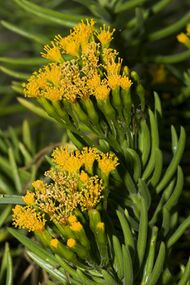
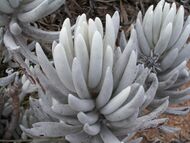
- Senecio ampullaceus — Texas ragwort, Texas squaw-weed, Texas groundsel, clasping-leaf groundsel[10]
- Senecio angulatus L.f. — creeping groundsel
- Senecio antisanae
- Senecio arborescens
- Senecio barbertonicus Klatt — succulent bush senecio
- Senecio bigelovii — nodding groundsel
- Senecio bosniacus G. Beck — Bosnian ragwort
- Senecio brasiliensis (Spreng.) Less. — flor-das-almas
- Senecio candicans — angel wings
- Senecio cambrensis — Welsh groundsel, Welsh ragwort
- Senecio crassissimus
- Senecio elegans — purple groundsel
- Senecio falklandicus
- Senecio flaccidus Less. — Douglas senecio, threadleaf groundsel, threadleaf ragwort
- Senecio gallicus Chaix — French groundsel
- Senecio glaucus L. — Jaffa groundsel
- Senecio howeanus
- Senecio inaequidens — South African ragwort
- Senecio iscoensis — Hieron.
- Senecio keniophytum
- Senecio lamarckianus
- Senecio leucanthemifolius Poir. — coastal ragwort
- Senecio madagascariensis — Madagascar ragwort
- Senecio macroglossus — Natal ivy, wax ivy
- Senecio neowbsteri Olympic Mountain groundsel
- Senecio patagonicus
- Senecio pauciradiatus
- Senecio pulcher
- Senecio sanmarcosensis
- Senecio squalidus — Oxford ragwort
- Senecio trapezuntinus
- Senecio triangularis — arrowleaf groundsel
- Senecio tropaeolifolius — false nasturtium
- Senecio vaginatus
- Senecio vernalis — eastern groundsel
- Senecio viscosus — sticky ragwort
- Senecio vulgaris — common groundsel, old-man-in-the-spring
Formerly in Senecio
- Brachyglottis greyi (as S. greyi)
- Pericallis × hybrida (as S. cruentus)
- Rugelia nudicaulis — Rugels ragwort
Distribution
The genus Senecio is distributed almost worldwide.[5] It is one of the few genera occurring in all five regions with a Mediterranean climate. Furthermore, species are found in mountainous regions, including tropical alpine-like areas.
See also
- Ragwort Control Act 2003
References
- ↑ 1.0 1.1 1.2 Germplasm Resources Information Network (GRIN) (2007-05-04). "Genus: Senecio L.". Taxonomy for Plants. USDA, ARS, National Genetic Resources Program, National Germplasm Resources Laboratory, Beltsville, Maryland. http://www.ars-grin.gov/cgi-bin/npgs/html/genus.pl?11063.
- ↑ Sunset Western Garden Book, 1995:606–607
- ↑ Pelser, Pieter B.; Tepe, Eric J.; Kennedy, Aaron H.; Watson, Linda E. (2013-06-10). "The fate of Robinsonia (Asteraceae): sunk in Senecio , but still monophyletic?". Phytotaxa 5 (1): 31–46. doi:10.11646/phytotaxa.5.1.2. ISSN 1179-3163.
- ↑ Taylor, Ronald J. (1994) (in en). Sagebrush Country: A Wildflower Sanctuary (rev. ed.). Missoula, MT: Mountain Press Pub. Co. pp. 156. ISBN 0-87842-280-3. OCLC 25708726. https://www.worldcat.org/oclc/25708726.
- ↑ 5.0 5.1 5.2 5.3 5.4 5.5 Pelser, Pieter B.; Nordenstam, Bertil; Kadereit, Joachim W.; Watson, Linda E. (2007). "An ITS Phylogeny of Tribe Senecioneae (Asteraceae) and a New Delimitation of Senecio L". Taxon 56 (4): 1077. doi:10.2307/25065905.
- ↑ Passalacqua, Nicodemo G.; Peruzzi, Lorenzo; Pellegrino, Giuseppe (August 2008). "A Biosystematic Study of the Jacobaea maritima Group (Asteraceae, Senecioneae) in the Central Mediterranean Area". Taxon 57 (3): 893–906. doi:10.1002/tax.573018.
- ↑ Frodin, David G. (2004). "History and concepts of big plant genera". Taxon 53 (3): 753–76. doi:10.2307/4135449.
- ↑ Pelser, Pieter B.; Kennedy, Aaron H.; Tepe, Eric J.; Shidler, Jacob B.; Nordenstam, Bertil; Kadereit, Joachim W.; Watson, Linda E. (2010-05-01). "Patterns and causes of incongruence between plastid and nuclear Senecioneae (Asteraceae) phylogenies". American Journal of Botany 97 (5): 856–873. doi:10.3732/ajb.0900287. ISSN 0002-9122. PMID 21622451.
- ↑ Norton, D.A. (1986). "Recent changes in the names of New Zealand tree and shrub species". New Zealand Journal of Forestry 31: 39–40. http://www.nzjf.org/free_issues/NZJF31_3_1986/8B94A164-BF7A-4A5B-A45B-3ACE982D0C7C.pdf. Retrieved 2008-04-10.
- ↑ Sean Claes (2007-04-16). "Proceed With Caution". Kyle, Texas Daily Photo. http://kyledailyphoto.blogspot.com/2007_04_01_archive.html#1746781956987590057.
External links
- Natural Resources Conservation Service (NRCS). "PLANTS Profile, Senecio L.". The PLANTS Database. United States Department of Agriculture. http://plants.usda.gov/java/profile?symbol=SENEC.
- "Senecio Succulents". Planet Desert. https://planetdesert.com/pages/search-results-page?q=senecio.
- Germplasm Resources Information Network (GRIN) (2005-10-26). "Genus: Senecio L.". Taxonomy for Plants. USDA, ARS, National Genetic Resources Program, National Germplasm Resources Laboratory, Beltsville, Maryland. http://www.ars-grin.gov/cgi-bin/npgs/html/genus.pl?11063.
- {{cite web
| url = http://www.ars-grin.gov/cgi-bin/npgs/html/splist.pl?11063 | title = GRIN Species Records of Senecio | access-date = 2008-03-06 | author = Germplasm Resources Information Network (GRIN) | date = 2005-10-26 | work = Taxonomy for Plants | publisher = USDA, ARS, National Genetic Resources Program, National Germplasm Resources Laboratory, Beltsville, Maryland
- Integrated Taxonomic Information System Organization (ITIS) (20 December 2007). "Senecio L.". Integrated Taxonomic Information System on-line database. https://www.itis.gov/servlet/SingleRpt/SingleRpt?search_topic=TSN&search_value=36084.
- "Details for: Senecio". Euro+Med PlantBase. Freie Universität Berlin. http://ww2.bgbm.org/EuroPlusMed/PTaxonDetail.asp?NameId=122653&PTRefFk=7000000.
- Missouri Botanical Garden (1753). "Seneco L.". Tropicos Nomenclatural Data Base. http://mobot.mobot.org/cgi-bin/search_vast?onda=N40035317.
- Royal Botanic Garden Edinburgh. "Flora Europaea Search Results". http://193.62.154.38/cgi-bin/nph-readbtree.pl/feout?FAMILY_XREF=&GENUS_XREF=Senecio.
- Flora of Israel Online. "Search Results For 'senecio'". Hebrew University of Jerusalem. http://www.flora.huji.ac.il/browse.asp?action=freesearch&q=Senecio.
- Jerusalem Botanical Gardens. "LIST OF ALL PLANTS NAMES -WITH PHOTO S". http://www.botanic.co.il/a/holiday/IMGMAP/PlantsNames.HTML#S.
- Flora of North America. Family List: 215. Senecio Linnaeus. 20. pp. 540, 541, 542, 543, 544, 545, 570, 615. http://www.efloras.org/florataxon.aspx?flora_id=1&taxon_id=130085. Retrieved 2008-03-06.
- "Senecio L.". African Flowering Plants Database. Conservatoire et Jardin botaniques de la Ville de Genève. http://www.ville-ge.ch/cjb/bd/africa/genre.php?langue=an&id=3152.
- Instituto Darwinion. "Asteraceae" (in es) (PDF). Catálogo de las Plantas Vasculares de la República Argentina. II. Universidad de Buenos Aires. pp. 255. http://www.darwin.edu.ar/Publicaciones/CatalogoVascII/asteraceae.zip.
- Helen Coleman, FloraBase: Flora of Western Australia (1997-06-18). "search term: Senecio". Flora Descriptions. Government of Western Australia. http://florabase.calm.wa.gov.au/search/quick?q=Senecio.
- Landcare Research. "Senecio L.". Flora of New Zealand: Taxa. Landcare Research Allan Herbarium and New Zealand Plant Names Database. http://floraseries.landcareresearch.co.nz/pages/Taxon.aspx?id=_052a7e9e-a00f-4666-a5a0-9f792748eb41&fileName=Flora%204.xml.
- "Search for:genus:Senecio". Species Information. Calflora — 1700 Shattuck Ave. #198, Berkeley, CA 94709. http://www.calflora.org/cgi-bin/specieslist.cgi?where-genus=Senecio&orderby=taxon&ttime=1202537565.
- Flora of Chile. Volume 4 Asteraceae Senecio L. 4. http://www.efloras.org/web_page.aspx?flora_id=60&page_id=1094. Retrieved 2008-03-06.
- {{cite web
| url = http://www.plantatlas.usf.edu/result.asp?search=Senecio&search_by=Sci_Name&qualifier=Any&EPPC=ANY&synonyms=include&native=ANY&NWI=ANY&WAP=ANY&DEP=ANY&endemic=ANY&FLStatus=Any&USStatus=Any&county_name=ANY&NumPerPage=90&curpage=1&FlgNoSciRecords=0 | title = Search Results For Search String: Senecio | access-date = 2008-03-06 | author = Richard Wunderlin or Bruce Hansen | year = 2006 | work = Atlas of Florida Vascular Plants | publisher = Institute for Systematic Botany
- "Asteraceae" (in es). Primera página de la especie. Malezas de México. http://www.conabio.gob.mx/malezasdemexico/asteraceae/.
- PlantNET — The Plant Information Network System of Botanic Gardens Trust. "Search terms: Senecio". Botanic Gardens Trust. http://plantnet.rbgsyd.nsw.gov.au/cgi-bin/NSWfl.pl?page=nswfl&search=yes&namesearch=Senecio&showsyn=OK&dist=.
- University of Wisconsin–Stevens Point. "Senecio L.". Robert W. Freckmann Herbarium. http://wisplants.uwsp.edu/scripts/photolink.asp?SpCode=SEN-.
- {{cite web
| url = http://www.rhs.org.uk/rhsplantfinder/plantfinder2.asp?crit=Senecio | title = RHS PLANT FINDER | access-date = 2008-03-06 | author = Royal Horticultural Society
Wikidata ☰ Q209596 entry
 |
